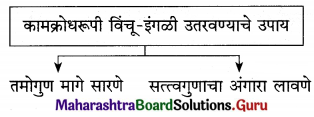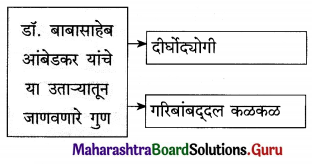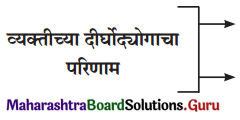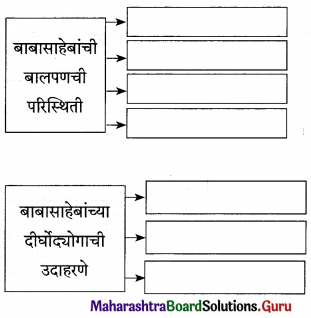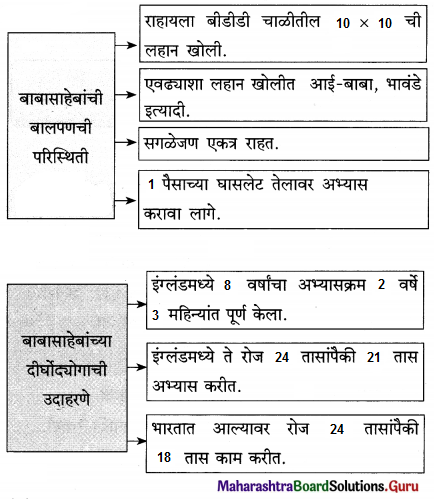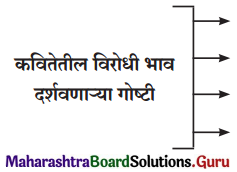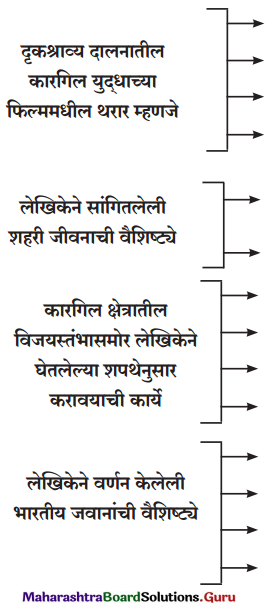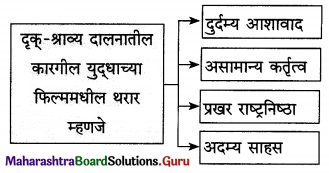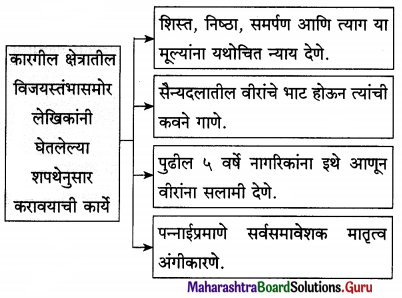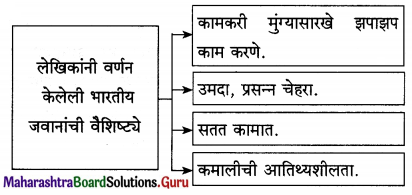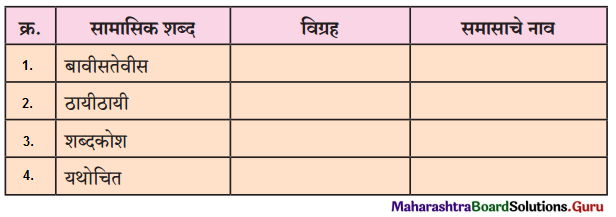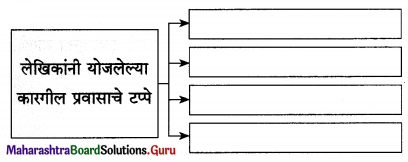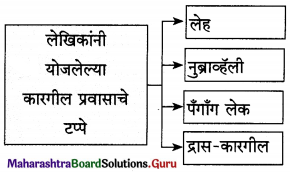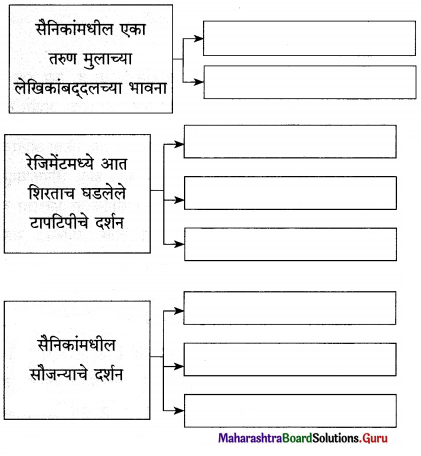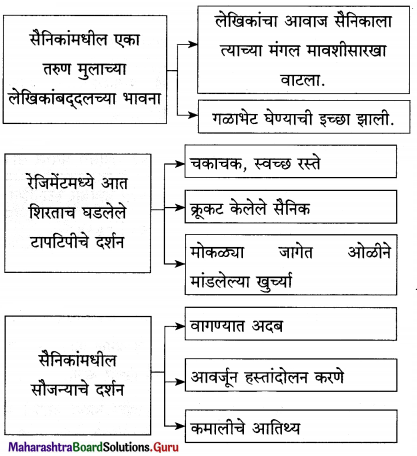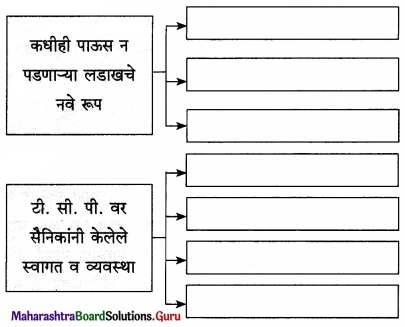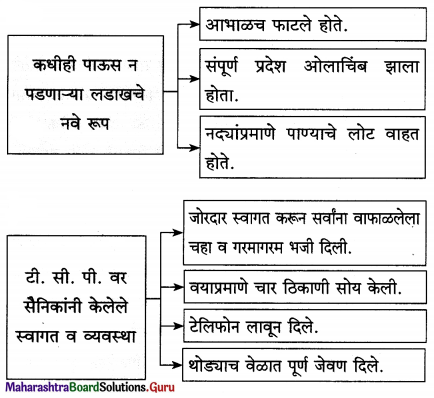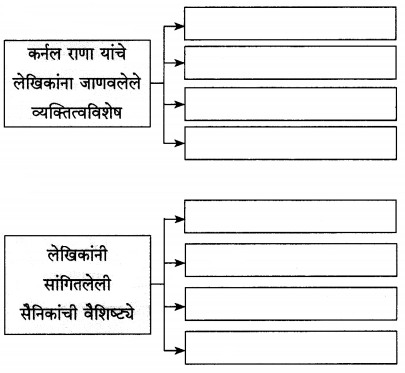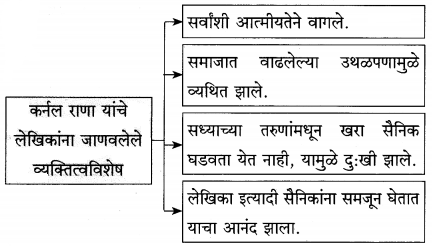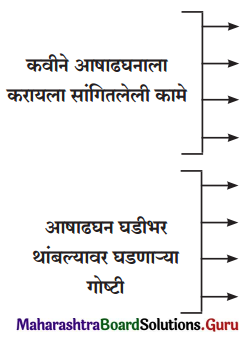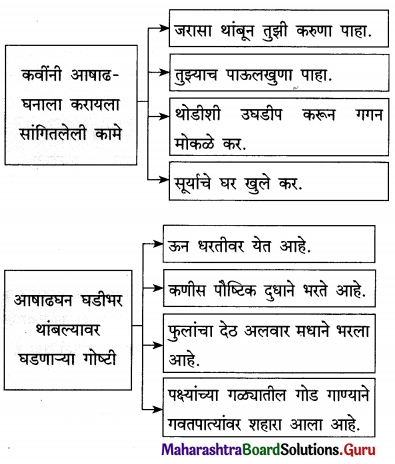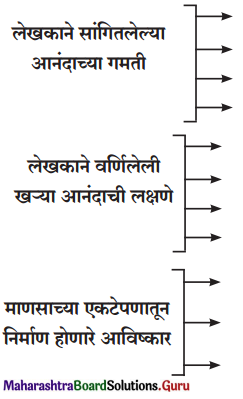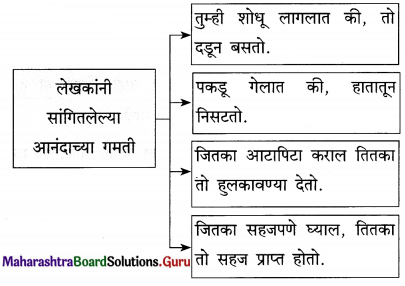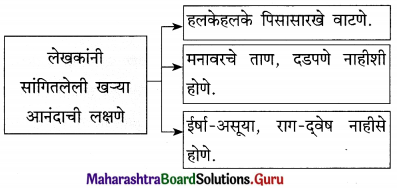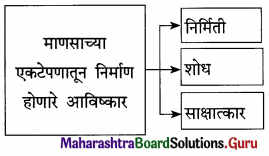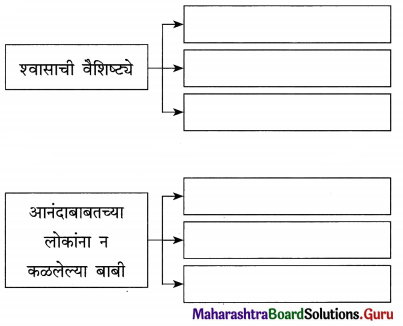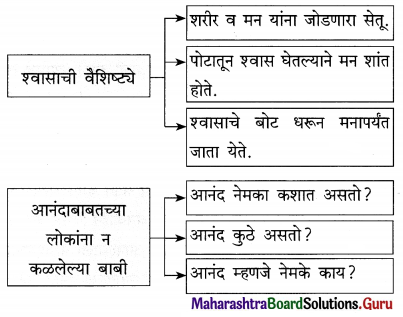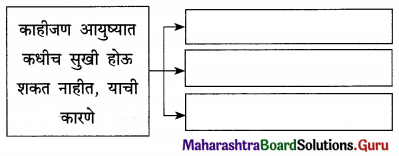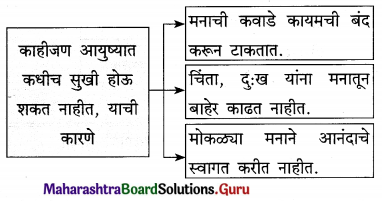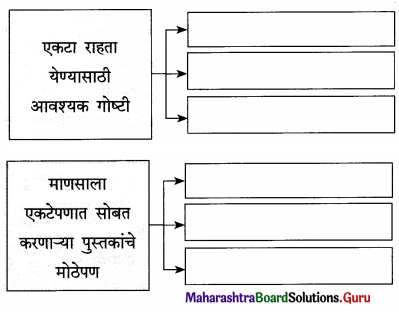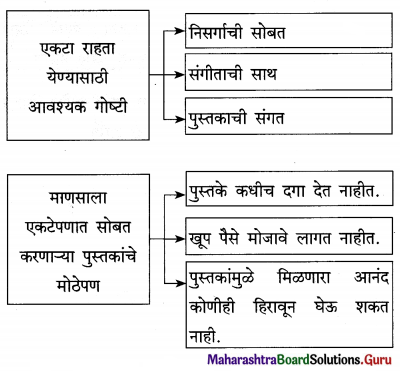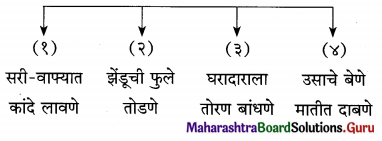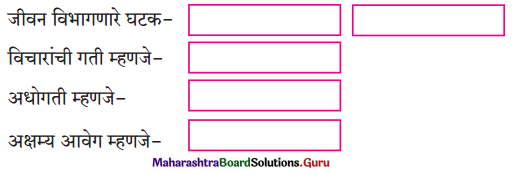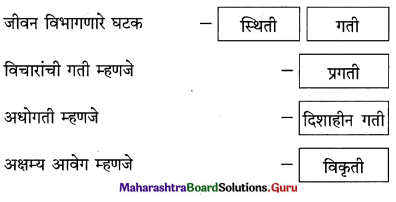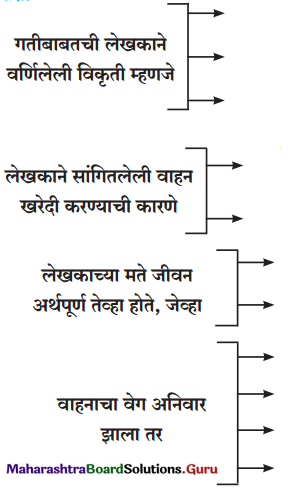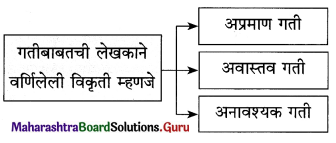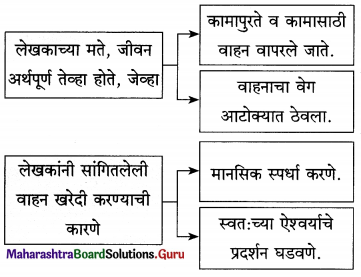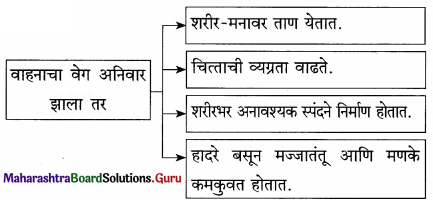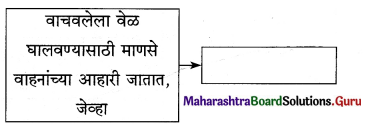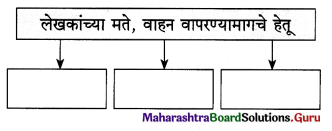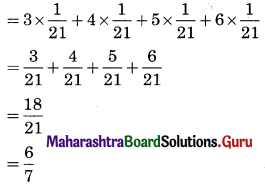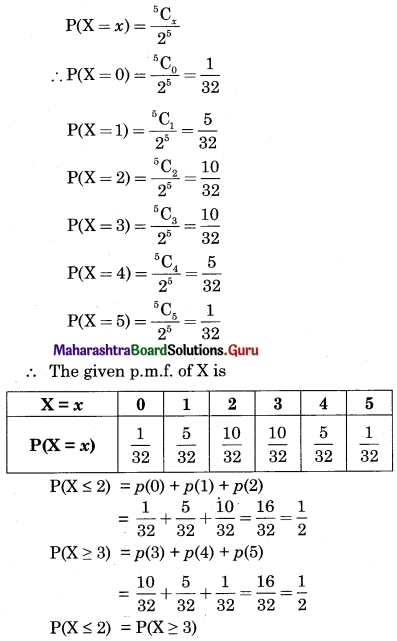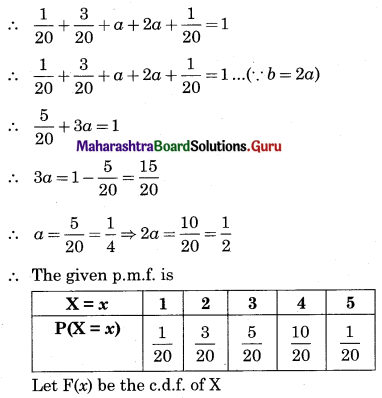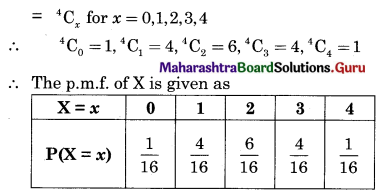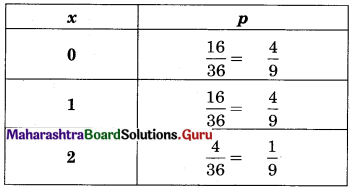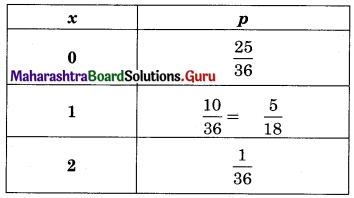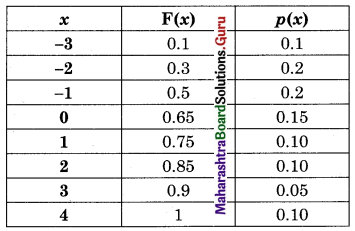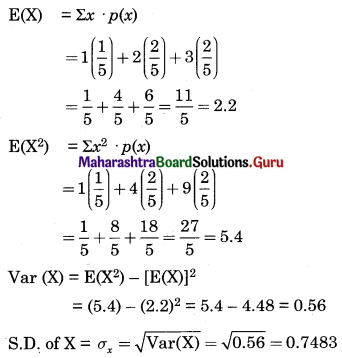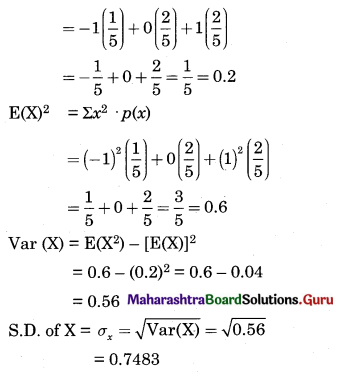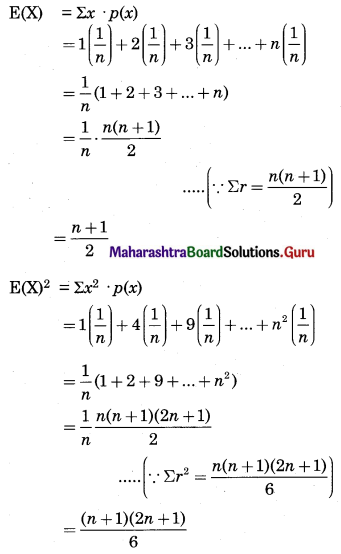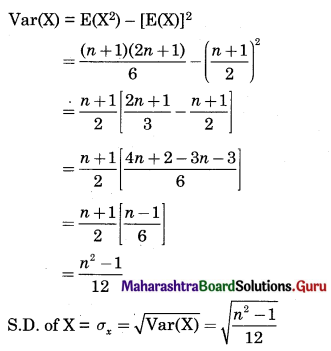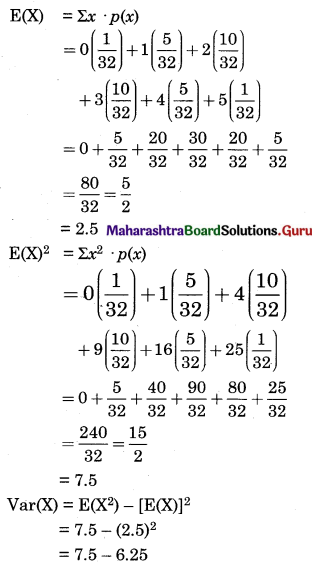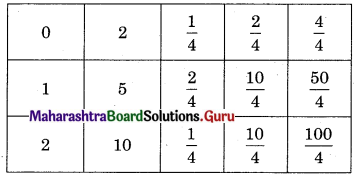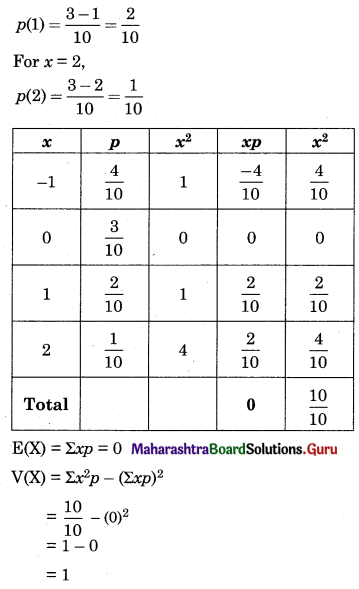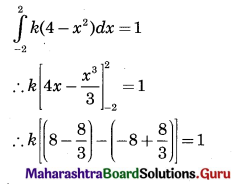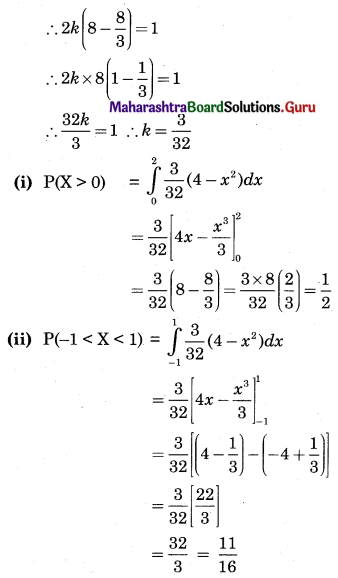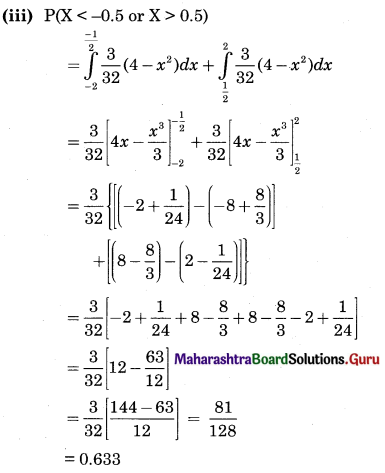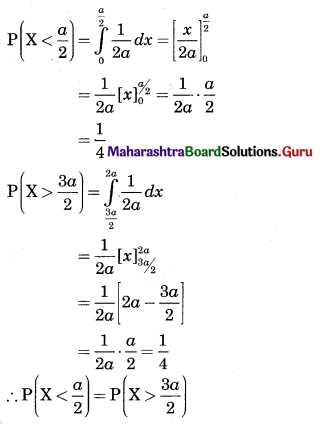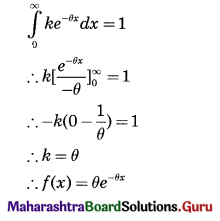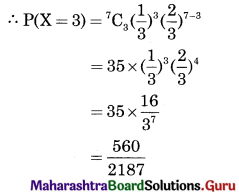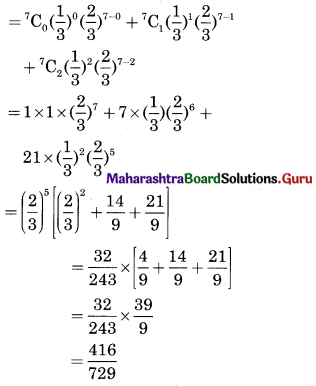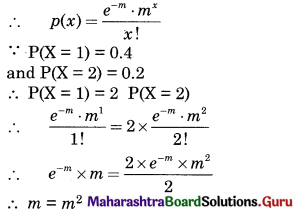12th Marathi Chapter 8 Exercise Question Answer Maharashtra Board
Balbharti Maharashtra State Board Marathi Yuvakbharati 12th Digest Chapter 8 रेशीमबंध Notes, Textbook Exercise Important Questions and Answers.
रेशीमबंध 12 वी मराठी स्वाध्याय प्रश्नांची उत्तरे
12th Marathi Guide Chapter 8 रेशीमबंध Textbook Questions and Answers
कृती
1. कृती करा.
प्रश्न अ.

उत्तर :
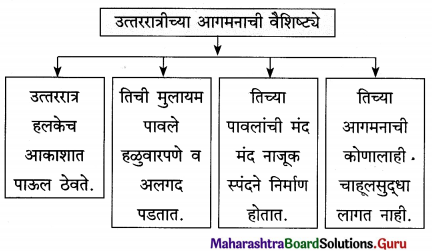
प्रश्न आ.
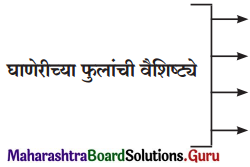
उत्तर :
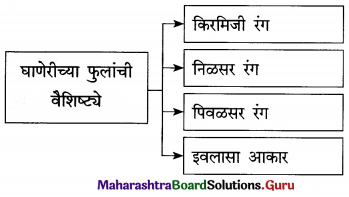
प्रश्न इ.

उत्तर :

प्रश्न ई.

उत्तर :

2. कारणे शोधा व लिहा.
प्रश्न अ.
पाखरांचा चिवचिवाट सुरू झालेला नसतो, कारण…
उत्तर :
पाखरांचा चिवचिवाट सुरू झालेला नसतो; कारण नुकते कुठे तीन-साडेतीन वाजलेले असतात.
![]()
प्रश्न आ.
मानवाला निसर्गाची ओढ लागते, कारण…
उत्तर :
मानवाला निसर्गाची ओढ लागते; कारण माणसाच्या मनात आदिमत्वही भरून राहिलेले असते.
3. अ. पहाटेच्या वेळी बागेत प्रवेश केल्यानंतर लेखकाला खालील फुलांसंदर्भात आलेले अनुभव लिहा.
प्रश्न 1.
सायली –
उत्तर :
सायलीच्या इवल्या इवल्या पानांतून एक वेगळीच हिरवाई वाहू लागते.
प्रश्न 2.
गुलमोहोर –
उत्तर :
गुलमोहोराजवळ जावं तर त्यानं स्वागतासाठी, केशरी सडाच शिंपून ठेवलेला असतो
![]()
प्रश्न 3.
जॅक्रांडा –
उत्तर :
जॅक्रांडाची निळीजांभळी फुलं रक्तचंदनी चाफ्याशी बिलगून गप्पागोष्टी करत असतात.
प्रश्न 4.
चाफा –
उत्तर :
चाफ्यांजवळ जावं तर त्यांच्या फुलांचा एक वेगळाच मंद मंद गंध येत असतो; पण तो निशिगंधासारखा मात्र नसतो.
आ. वर्णन करा.
प्रश्न 1.
उत्तररात्रीचे आगमन
उत्तर :
मध्यरात्र उलटली की उत्तररात्र हलकेच आकाशात पाऊल टाकते. उत्तररात्रीची पावले मुळातच मुलायम, त्यात ती रात्र आपली मुलायम पावले हळुवारपणे, अलगद ठेवीत येते. कुणालाही चाहूल लागणे कठीण. मात्र लेखकांचे उत्तररात्रीशी अत्यंत जवळिकेचे नाते आहे. त्यामुळे तिच्या पावलांची मंद मंद नाजूक स्पंदने लेखकांच्या मनात उमटत राहतात. लेखकांना झोप लागत नाही. आपली झोप जणू पूर्ण झाली आहे, असेच त्यांना वाटत राहते.
![]()
प्रश्न 2.
पहाट व पाखरे यांच्यातील नात
उत्तर :
लेखकांना भोवतालचा निसर्ग माणसासारखाच भावभावनांनी भरलेला भासतो. पहाटेची घटना तशी साधीशीच. पहाट होत आहे. पाखरांचा बारीक बारीक आवाज सुरू झाला आहे. त्यांच्या हालचालींना सुरुवात होत आहे. पहाट हळूहळू पुढे सरकत आहे. या प्रसंगात लेखकांना मानवी भावभावनांचे दर्शन घडते. पाखरांचा बारीक बारीक आवाज म्हणजे त्यांची कुजबुज होय. ती जणू एकमेकांना विचारताहेत, ” पहाट आली का? ” पहाटेचे हळुवार येणे पाहून लेखकांना वाटते की, पाखरांना त्रास होऊ नये म्हणूनच जणू पहाट हळूच पाखरांना विचारते की, “मी येऊ का?” त्या दोघांमधले हळुवार कोमल नातेच लेखकांना या वाक्यातून व्यक्त करायचे आहे.
इ. खालील घटकांच्या संदर्भात पाठात आलेल्या मानवी क्रिया लिहा.
प्रश्न 1.
- वृक्ष – …………..
- वेली – …………
- फुले – ………..
- पाखरे – ………….
उत्तर :
- वृक्ष – डोळा लागलेला असतो.
- वेली – डोळा लागलेला असतो.
- फुले – विसावलेली, सुखावलेली असतात.
- पाखरे – गाढ झोपलेली असतात.
4. व्याकरण.
अ. खालील वाक्प्रचारांचा अर्थ सांगून वाक्यात उपयोग करा.
प्रश्न 1.
मन समेवर येणे-
उत्तर :
अर्थ – मन शांत व एखाद्या गोष्टीशी एकरूप होणे.
वाक्य – राहुल रात्रभर भरकटणारे मन प्रभातफेरीसाठी बाहेर पडल्यावर एकदम समेवर आले.
प्रश्न 2.
साखरझोपेत असणे-
उत्तर :
अर्थ – पहाटेच्या गाढ स्वप्निल निद्रेत असणे.
वाक्य – पहाटे मोहन साखरझोपेत असताना बाहेर पाऊस पडत होता.
आ. खालील वाक्यांत योग्य विरामचिन्हांचा उपयोग करा.
प्रश्न 1.
खरं तर पहाटच त्यांना विचारत असते की मी येऊ का तुम्हांला भेटायला
उत्तर :
खरं तर पहाटच त्यांना विचारत असते, की ‘मी येऊ का तुम्हांला भेटायला?’
![]()
प्रश्न 2.
निशिगंध म्हणजे निशिगंधच
उत्तर :
निशिगंध म्हणजे निशिगंधच!
इ. खालील वाक्यांचा प्रकार ओळखून सूचनेप्रमाणे तक्ता पूर्ण करा.
प्रश्न 1.
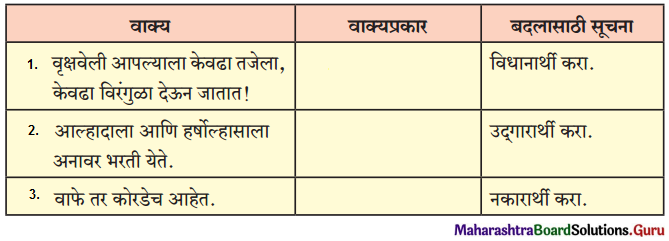
उत्तर :
वाक्यप्रकार → उद्गारार्थी वाक्य
विधानार्थी → वृक्षवेली आपल्याला तजेला आणि विरंगुळा देतात.
वाक्यप्रकार → विधानार्थी वाक्य
उद्गारार्थी → किती अनावर भरती येते आल्हादाला आणि हर्षोल्हासाला!
वाक्यप्रकार → होकारार्थी वाक्य
नकारार्थी → वाफे तर ओले नाहीतच.
ई. खालील तक्ता पूर्ण करा.
प्रश्न 1.

उत्तर :
| सामासिक शब्द | समासाचा विग्रह | समासाचे नाव |
| पांढराशुभ्र | शुभ्र असा पांढरा | कर्मधारय |
| वृक्षवेली | वृक्ष आणि वेली | इतरेतर द्वंद्व |
| गप्पागोष्टी | गप्पा, गोष्टी वगैरे | समाहार द्वंद्व |
| सुखदुःख | सुख किंवा दुःख | वैकल्पिक द्वंद्व |
![]()
उ. खालील वाक्यांतील प्रयोग ओळखा व लिहा.
प्रश्न 1.
- खिडकी हलकेच उघडतो.
- मानवाला निसर्गाची ओढ लागून राहिली.
- तुम्हांलाही त्यातला आल्हाद जाणवेल.
उत्तर :
- कर्तरी प्रयोग
- कर्मणी प्रयोग
- भावे प्रयोग
5. स्वमत.
प्रश्न अ.
‘मानवाला निसर्गाची जी ओढ युगानुयुगांपासून लागून राहिली आहे, ती या आदिम, ॠजु, स्नेहबंधांमुळे तर नाही?…’ या विधानासंबंधी तुमचे मत लिहा.
उत्तर :
उत्तररात्रीचे दृश्य खरोखरच विलक्षण असते. सर्वत्र, सर्व काही शांतनिवांत असते. दिवसा इकडेतिकडे सतत धावणारी, कोणती ना कोणती कामे करीत राहणारी, एकमेकांशी बोलणारी, एकमेकांशी भांडणारी, एकमेकांवर प्रेम करणारी ही माणसे निवांत झोपलेली असतात. काहीजण दिवसा चिंतांनी ग्रासलेली असतात. काहीजण मिळालेल्या यशामुळे आनंदाच्या, सुखाच्या शिखरावर असतात. या सर्व भावभावना, सर्व सुखदु:खे उत्तररात्रीच्या क्षणांमध्ये विरून गेलेल्या असतात.
दुष्ट विचार, दुष्ट भावना आणि चांगल्या माणसांच्या मनातले चांगले विचार, चांगल्या भावना हे सर्व काही त्या क्षणी दूर निघून गेलेले असते. माणसे भांडतात तेव्हाचे त्यांचे भाव आठवून पाहा. सर्व त्वेष, द्वेष, राग, संताप उफाळून आलेला असतो. तीच माणसे उत्तररात्री या सर्व भावभावनांचे गाठोडे बाजूला ठेवून निवांत झालेली असतात. सज्जन व दुर्जन दोघेही शेजारी शेजारी झोपलेले असतील, तर त्यांच्यातला चांगला कोण व वाईट कोण हे नुसते पाहून ठरवताच येणार नाही. त्या क्षणी सर्वांचे मन निर्मळ, शुद्ध झालेले असते.
सर्व प्राणिमात्रांमध्ये, वनस्पतींमध्ये हाच शुद्ध भाव वसत असतो. आणि हा शुद्ध भाव अनादी काळापासून सर्वांच्या मनात वस्ती करून आहे. माणसाचे मन या मूळ भावनेकडेच धाव घेत असते. आदिम खूप खूप पूर्वीचे. ऋजू म्हणजे साधे, सरळ, निर्मळ, पारदर्शी. त्यात कोणतेही किल्मिष, वाईट भावनेचा लवलेशही नसतो. सगळ्यांच्याच ठायी हा भाव असल्याने सर्वजण एकमेकांशी हसतखेळत बोलू शकतात. एकमेकांच्या मदतीला धावतात. एकमेकांवर प्रेम करतात. त्या शुद्ध, निर्मळ भावनेने एकमेकांशी बांधले जातात. लेखकांना या वाक्यातून हेच सांगायचे आहे.
![]()
प्रश्न आ.
‘रेशीमबंध’ या शीर्षकाची समर्पकता तुमच्या शब्दांत लिहा.
उत्तर :
लेखकांचे निसर्गाशी अत्यंत कोमल, हळुवार, नाजूक नाते आहे. त्यांच्या मते, सर्व माणसांचेच तसे नाते असते. या हळुवार, कोमल नात्याचे दर्शन लेखक या पाठात घडवतात. हे नाते रेशमासारखे तलम, मुलायम आहे. म्हणून ते रेशीमबंध.
हे रेशीमबंध लेखकांनी अत्यंत मुलायमपणे, हळुवारपणे उलगडून दाखवले आहेत. नीरव शांततेत उत्तररात्र हळुवारपणे कोमल पावले टाकत येते. कोणाला चाहूलही लागत नाही. पण लेखकांच्या मनात त्या मुलायम पावलांची मंद मंद स्पंदने उमटतात. त्यांचे मन तितक्याच हळुवारपणे ती स्पंदने टिपते. त्यांच्या निसर्गाशी असलेल्या नात्याचा रेशमी मुलायम पण इथे जाणवतो.
साखरझोपेत जग विसावलेले असते. साऱ्या काळज्या-चिंता मिटून गेलेल्या असतात. मन सुखदुःखांच्या पलीकडे गेलेले असते. एक निर्मळ, शुद्ध असे स्वरूप मनाला प्राप्त होते. निसर्गाचा आत्माच त्यात असतो. लेखकांचे नाते या निर्मळपणाशी, त्या आत्म्याशी जडले आहे. त्यांना त्यांच्या नातीच्या शैशवातला नितळपणा जाणवतो.
या नितळपणाचा संबंध निसर्गाच्या आत्म्याशी, निर्मळपणाशी आहे. कोणालाही चाहूल लागू न देता पहाट अलगद अवतरते, पण लेखक अत्यंत संवेदनशील असल्याने त्यांना चाहूल लागते. त्या अनोख्या, नाजूक, तरल क्षणाचा लेखकांना अनुभव येतो. बागेतल्या वृक्षवेलींच्या रूपांनी, त्यांचे विविध रंग व सुगंध यांच्या रूपांनी लेखकांना स्वत:चे आदिमतेशी असलेले नाते जाणवते.
या पाठात लेखक निसर्गाशी असलेल्या स्वत:च्या नात्याचा शोध घेत आहेत. स्वतः प्रमाणे सगळीच माणसे निसर्गाशी कोमल, नाजूक, हळुवार भावनांनी बांधली गेली आहेत. ते बंध सहजासहजी दिसत नाहीत; दाखवून देता येत नाहीत. ते सूक्ष्म, तरल, कोमल भावनांचे बंध असतात. ते रेशमाप्रमाणे तलम, मुलायम असतात. म्हणून लेखक या बंधांना रेशीमबंध म्हणतात. संपूर्ण पाठाच्या केंद्रस्थानी हे रेशीमबंधच आहेत. म्हणून या पाठाला रेशीमबंध’ हे शीर्षक खूप साजते.
6. अभिव्यक्ती.
प्रश्न अ.
निसर्ग आणि मानव यांच्यातील परस्परसंबंध तुमच्या शब्दांत स्पष्ट करा.
उत्तर :
मला कळू लागले तेव्हापासूनचे सर्व आठवते. कधीही फिरायला जाण्याची कल्पना आली, सहलीला जाण्याची वेळ आली की, मला प्रचंड आनंद होतो. खरे सांगायचे तर मला एकट्यालाच असे वाटते, असे नाही. आमच्या वर्गातल्या सर्व मित्रमैत्रिणींना सहलीचा विषय आला की, अमाप आनंद होतो. सहलीला गेलो, निसर्गात गेलो की, खूप आनंद मिळतो. नदीत डुंबायला मिळाले तर कितीही वेळ डुंबत राहावेसे वाटते. तेच रानावनात भटकतानाही वाटत असते. झाडांच्या सोबत वावरताना कंटाळा येतच नाही. हिरव्यागार वृक्षवेलींनी सजलेला डोंगर पाहताना मन सुखावते. हे असे का होत असावे?
वनस्पती या सजीव आहेत; त्यांना माणसांसारख्याच भावभावना असतात. वनस्पतींनाही आनंद होतो, दुःख होते. त्यांच्यावर प्रेमाने हात फिरवला, तर त्याही सुखावतात, हे सर्व आता लहानथोरांपासून सर्वांनाच ठाऊक झाले आहे. प्रत्येक ऋतूशी माणसाचे भावनिक नाते निर्माण झाले आहे. म्हणूनच तर झाडे सुकून जाऊ लागली की माणसाचे मन कळवळते. वृक्ष नष्ट होऊ लागले की माणसाला दुःख होते. वृक्षतोड होताना दिसली की, माणसे खवळतात. शहरात माणसाला स्वत:चे वृक्षप्रेम जपता येत नाही, म्हणून माणसे कुंड्यांमध्ये रोपटी लावतात आणि त्यांचा आनंद घेतात. अमाप वृक्षतोड होऊ लागली, तेव्हा सुंदरलाल बहुगुणा या वृक्षप्रेमीने ‘चिपको आंदोलन’ उभारले. त्याला देशभर प्रचंड प्रतिसाद मिळाला.
लोकांच्या मनात हे एवढे वृक्षप्रेम दाटून आले, याचे कारणच हे की निसर्ग आणि आपण यांच्यात एक खोलवरचे नाते आहे. ज्या निसर्गाने माणसांना निर्माण केले, त्यानेच प्राण्यांना आणि वनस्पतींना निर्माण केले आहे. आपण सर्व निसर्गाची लेकरे आहोत. आपण, अन्य प्राणी आणि वनस्पती ही सर्व भावंडेच आहेत. आपणा सर्वांमध्ये हे असे रक्ताचेच नाते आहे. निसर्गच आपले पालनपोषण करतो. तोच अन्नपाणी देतो. तोच हवाही देतो. आपल्याला तोच जिवंत ठेवतो. आपल्या जगण्याचा आधारच निसर्ग हा आहे. हेच निसर्ग व मानव यांच्यातले नाते आहे.
![]()
प्रश्न आ.
डॉ. यू. म. पठाण यांच्या लेखनाची भाषिक वैशिष्ट्ये पाठाधारे स्पष्ट करा.
उत्तर :
डॉ. यू. म. पठाण यांच्या भाषेचे सर्वांत पहिले जाणवणारे वैशिष्ट्य म्हणजे त्यांची साधी, सरळ, भाषा स्वतःचा अनुभव ते पारदर्शीपणे व्यक्त करतात. उत्तररात्रीचे आकाशात पडणारे पाऊल हळुवारपणे, अलगद, मुलायम, कुणालाही चाहूल लागू न देणारे’ असे असते. पावलाचा हळुवारपणा, नाजुकपणा, मुलायम पण त्या वाक्यातून सहज प्रत्ययाला येतो. उदा., उत्तररात्र प्रवेश करते, त्याचे वर्णन करणारे वाक्य पाहा – ‘उत्तररात्रीने हलकेच आकाशात पाऊल ठेवलेलं असतं येथे पाऊल ‘पडत’ नाही किंवा ‘टाकले जात नाही. उत्तररात्र ‘हलकेच पाऊल ठेवते’ अत्यंत योग्य अशा क्रियापद योजनेमुळे भाषेतून व्यक्त होणाऱ्या अनुभवाचा प्रत्यय येतो. वाचकाला ती भाषा भावते. हे एक उदाहरण झाले. पण संपूर्ण पाठभर अशी अनुभवाचा प्रत्यय देणारी भाषा आढळते.
लेखकांना सृष्टीतले मानवेतर घटक कोरडे, भावनाविरहित वाटतच नाहीत. ते त्यांना माणसांप्रमाणेच भावभावनांनी भिजलेले, सजीव, चैतन्यपर्ण वाटतात. ते घटक वर्णनामध्ये मानवी रूपच घेऊन येतात. म्हणून पाखरे ‘हळूहळू डोळे किलकिले’ करून पाहतात. पहाटेच्या प्रकाशकिरणांना ‘खुणावतात ‘. पाखरे ‘कुजबुजली’. बोगनवेल ‘सळसळू’ लागते. दोन्ही वाफे ‘एकमेकांशी हितगुज’ करतात. मोगरा ‘खुदखुद हसतो’. तो कधी रुसून बसतो’. झाडे-वेली ‘भावुक होतात’ अशा रितीने सर्व घटक मानवी रूप घेऊन येतात. लेखन हृद्य बनते. लेखनातला अनुभव भावभावनांशी रसरशीत बनतो.
उत्तररात्री आगमन, सुख दुःखाच्या पलीकडे गेलेले मन, त्यांच्या नातीच्या शैशवातला नितळपणा, पहाटेचे अलवार आगमन असे अत्यंत तरल, मुलायम, नाजूक अनुभव प्रत्ययदर्शी होतात. आणखी एक वैशिष्ट्य बघा. असं कोणतं बरं नातं’, ‘का बरं म्हटलं असावं’ ही शब्दरूपे पाहा. ही छापील वळणाची शब्दरूपे नाहीत. ही दैनंदिन जीवनातली बोलण्यातली शब्दरूपे आहेत. एखादा माणूस आपल्या जिवलग मित्राशी जिवाभावाच्या गप्पागोष्टी करीत बसला असावा, तसे हा लेख वाचताना वाटत राहते. म्हणूनच संपूर्ण लेखात भाषेला एक वेगळाच गोडवा प्राप्त झाल्याचे दिसून येते.
![]()
प्रश्न इ.
संत तुकाराम महाराज यांनी वृक्षवल्लींना ‘सोयरी’ असे म्हटले आहे, यामागील तुम्हांला समजलेली कारणे लिहा.
उत्तर :
थोडा वेळ बागेत बसले, रानात फेरफटका मारला की, मनाला खूप आल्हाद मिळतो. शहरात आखीव रेखीव रस्ते आणि तशाच आखीव रेखीव इमारती. इमारतीतल्या प्रत्येक घराचा चेहरा सारखाच. याउलट, रानावनात सौंदर्याची मुक्त उधळण असते. तिथे एक झाड दुसऱ्या झाडासारखे नसते. एक पान दुसऱ्या पानासारखे नसते. एक हिरवा रंग पाहा.
त्या एका हिरव्या रंगांच्या शेकडो छटांचे दर्शन तिथे घडते. हजारो आकार, हजारो रंग, हजारो आवाज, हजारो गंध. तिथे पंचेद्रियांच्या सुखाची लयलूट असते. किती विविधता! पक्षी, प्राणी, किडेमुंग्या यांच्या हजारो जाती. त्यांच्यातही रंग, आकार, हालचाली यांचे हजारो प्रकार. निसर्गातली ही विविधता मनाला मोहवते. मन त्या सौंदर्यात बुडून जाते. कृत्रिमतेची चढलेली पुटे हळूहळू गळून पडतात. मन मोकळे होते. सौंदर्याचा, आनंदाचा अनुभव घेऊ लागते.
तुकाराम महाराजांनी विठ्ठलभक्तीसाठी वनाचाच आश्रय घेतला. माणसात असलेल्या सर्व कुभावनांपासून मुक्ती मिळावी; आपला आत्मा त्या कुभावनांपासून मुक्त व्हावा; ईश्वराचे निर्मळ, सोज्वळ रूप दिसावे; त्याच्याशी एकरूप होता यावे; म्हणून त्यांनी वन गाठले. वनात गेले की मन आपसूक मुक्त होते. मनाची ही अवस्था ईश्वराकडे जाण्यासाठी उत्तम अवस्था. वनाचे सौंदर्य म्हणजे ईश्वराचे एक रूपच, त्या रूपाच्या सान्निध्यात राहावे, षड्रिपू चा त्याग करावा म्हणजे आपण अलगद ईश्वराच्या जवळ जाऊन ठेपतो.
आपल्याला सर्व सुंदर, निर्मळ, चांगलेच दिसते. या चांगुलपणाचाच आस्वाद घेत राहावा, असे वाटू लागते. म्हणजे ईश्वराच्या दर्शनातच, त्याच्या स्मरणातच आकंठ बुडून जावे अशी अवस्था होऊन जाते. तुकाराम महाराजांना वृक्षवल्ली सोयरी वाटली ती या कारणाने. या वृक्षवल्लींच्या ठायी माणसाचे दुर्गुण नसतात. ती ईश्वराची रूपे होत. त्यांच्या सहवासातच ईश्वरभक्ती फुलते. वृक्षवल्ली, सर्व वनश्री आपल्याला ईश्वराच्या वाटेवर आणून सोडतात. तुकाराम महाराज म्हणूनच वृक्षवल्लींच्या सान्निध्यात गेले. वृक्षवल्लींना सोयरी’ मानले.
उपक्रम :
अ. तुमच्या परिसरातील देशी व विदेशी फुलांची माहिती इंटरनेटच्या माध्यमांतून मिळवून ती तुमच्या कनिष्ठ महाविदयालयातील काचफलकात प्रदर्शित करा.
आ. हिवाळ्यातील उत्तररात्री किंवा अगदी पहाटेच्या वेळी तुमच्या परिसराचे निरीक्षण करा. पाहिलेल्या निसर्गसौंदर्याचे वर्णन शब्दबद्ध करा. ते वर्गात वाचून दाखवा.
![]()
तोंडी परीक्षा.
शिक्षकांनी वाचून दाखवलेला उतारा ऐका. सारांश लिहा.
Marathi Yuvakbharati 12th Digest Chapter 8 रेशीमबंध Additional Important Questions and Answers
कृती करा.
प्रश्न 1.
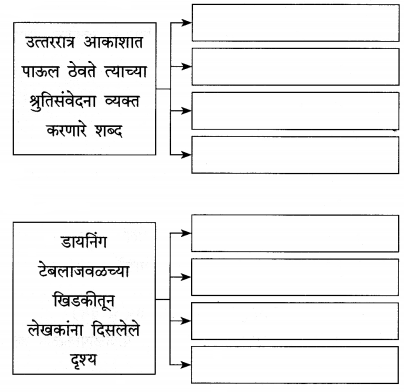
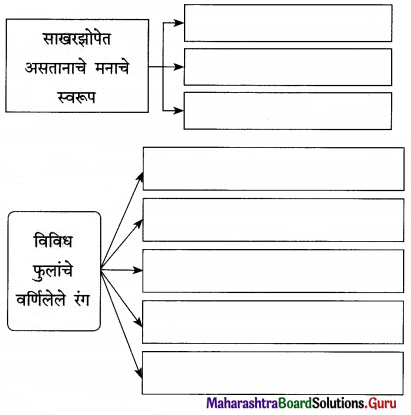
उत्तर :

प्रश्न 2.
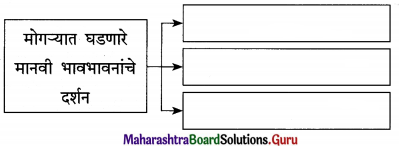
उत्तर :
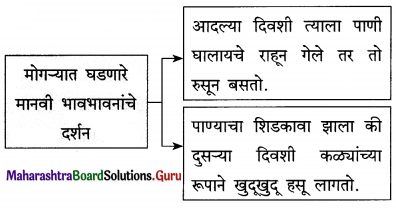
कारणे शोधा व लिहा.
प्रश्न 1.
उत्तररात्र हळुवारपणे अलगद पाऊल टाकते; कारण ………
उत्तर :
उत्तररात्र हळुवारपणे अलगद पाऊल टाकते; कारण तिच्या आगमनाची चाहूल कोणलाही लागू नये, अशी तिची इच्छा असते.
प्रश्न 2.
लेखक डायनिंग टेबलजवळची खिडकी हलकेच उघडतात कारण ……….
उत्तर :
लेखक डायनिंग टेबलजवळची खिडकी हलकेच उघडतात कारण रात्रीच्या नीरव शांततेचा भंग होऊ नये, असे लेखकांना वाटत असते.
![]()
प्रश्न 3.
पाखरांनी पंख फडफडल्याशिवाय पहाटदेखील आकाशात येत नाही; कारण ……….
उत्तर :
पाखरांनी पंख फडफडवल्याशिवाय पहाटदेखील आकाशात येत नाही; कारण पाखरांची झोपमोड होऊ नये, असे पहाटेला मनोमन वाटत असते.
प्रश्न 4.
निसर्ग आणि मानव यांना एकमेकांची ओढ लागलेली असते; कारण …………..
उत्तर :
निसर्ग आणि मानव यांना एकमेकांची ओढ लागलेली असते; कारण त्या दोघांमध्ये युगानुयुगे आदिम, ऋजू स्नेहबंध निर्माण झाले आहेत.
वर्णन करा :
प्रश्न 1.
1. पहाटेचे आगमन.
2. मोगऱ्यात घडणारे मानवी भावभावनांचे दर्शन.
3. उजाडत जाणाऱ्या पहाटेसोबत आल्हादाला येणारी भरती.
4. पहाट व पाखरे यांच्यातील नाते.
उत्तर :
1. पहाटेचे आगमन : उत्तररात्रीचा काळोख हळूहळू विरत जातो. हळुवारपणे उजाडू लागते. गुलमोहोरावरील घरट्यांतून, जैक्रांडाच्या फांदयांवरून पाखरे डोळे किलकिले करून पाहू लागतात. त्यांचा आपापसातला आवाज कुजबुजीसारखा भासू लागतो. हळूहळू एखादया उत्सवासारखा हा चिवचिवाट वाढत जातो. सायली, बोगनवेल, क्रोटन्स, गुलमोहोर, जॅक्रांडा हे सर्वच सळसळू लागतात. हलू डोलू लागतात. अशा प्रकारे पहाटेचे आगमन होते.
2. मोगऱ्यात घडणारे मानवी भावभावनांचे दर्शन : लेखकांचे निसर्गाशी असलेले अत्यंत हृदय असे नाते या उताऱ्यातून व्यक्त झाले आहे. भोवतालच्या वृक्षवेली, पाखरे, पहाट, सकाळ हे सर्व मानवेतर घटक माणसासारख्याच भावभावनांनिशी वावरू लागतात. म्हणूनच पाणी न मिळाल्यामुळे कोमेजलेला मोगरा लेखकांना रुसल्यासारखा भासतो आणि पाणी मिळाल्यावर कळया आल्या की खुदखुद हसल्यासारखा भासतो. झाडेवेली भावुक होतात. कधीतरी थोडीफार रुसलीफुगली तरी त्यांच्यावरून प्रेमाने हात फिरवला, त्यांना पाणी दिले की गोंडस फुले देऊन आपल्याला केवडातरी विरंगुळा, तजेला देतात. अशी मानवी भावनांची देवाणघेवाण लेखकांना जाणवत राहते.
3. उजाडत जाणाऱ्या पहाटेसोबत आल्हादाला येणारी भरती : उत्तररात्रीचा काळोख विरत जातो आणि पहाटेचा उजेड सुरू होतो. हा काळोख नेमका कोणत्या क्षणी संपतो आणि उजेड कोणत्या क्षणी सुरू होतो हे सांगणे केवळ अशक्य असते. इतका तो क्षण तरल असतो. त्या क्षणी लेखकांना अनोख्या, लोभसवाण्या नाजूक अनुभवाचा प्रत्यय येतो. ही आल्हाददायकता निसर्गाच्या सर्व घटकांमध्ये लेखकांना दिसते. झाडांच्या, वेलींच्या सळसळण्यात, हलण्याडोलण्यात दिसते. सुरुवातीला मंद मंद असलेला चिवचिवाट हर्षोल्हासाचे रूप धारण करतो. जणू आनंदाला, आल्हादाला आलेली भरतीच वाटते.
4. पहाट व पाखरे यांच्यातील नाते : लेखकांना भोवतालचा निसर्ग माणसासारखाच भावभावनांनी भरलेला भासतो. पहाटेची घटना तशी साधीशीच. पहाट होत आहे. पाखरांचा बारीक बारीक आवाज सुरू झाला आहे. त्यांच्या हालचालींना सुरुवात होत आहे. पहाट हळूहळू पुढे सरकत आहे. या प्रसंगात लेखकांना मानवी भावभावनांचे दर्शन घडते. पाखरांचा बारीक बारीक आवाज म्हणजे त्यांची कुजबुज होय. ती जणू एकमेकांना विचारताहेत, ” पहाट आली का?” पहाटेचे हळुवार येणे पाहन लेखकांना वाटते की, पाखरांना त्रास होऊ नये म्हणूनच जणू पहाट हळूच पाखरांना विचारते की, “मी येऊ का?” त्या दोघांमधले हळुवार कोमल नातेच लेखकांना या वाक्यातून व्यक्त करायचे आहे.
![]()
केव्हा ते लिहा :
प्रश्न 1.
1. पहाट आकाशात हलकेच पाऊल टाकते, जेव्हा
2. पाखरांचा चिवचिवाट वाढत जातो, जेव्हा
उत्तर :
1. पहाट आकाशात हलकेच पाऊल टाकते, जेव्हा पाखरांच्या पंखांची फडफड त्याला ऐकू येते.
2. पाखरांचा चिवचिवाट वाढत जातो, जेव्हा पहाट हळूहळू उजाडत जाते.
म्हणजे काय ते लिहा :
प्रश्न 1.
- गुलमोहोरावरची पाखरे आपापसात कुजबुजू लागतात, म्हणजे जणू काही ………
- मोगऱ्याला चुकून एखादया दिवशी पाणी घालायचे राहून गेले, तर तो कोमेजू लागतो, म्हणजे जणू काही ……
- पाण्याचा शिडकाव झाला की दुसऱ्या दिवशी मोगऱ्याला कळ्या येतात, म्हणजे जणू काही …………
उत्तर :
- गुलमोहोरावरची पाखरे आपापसात कुजबुजू लागतात, म्हणजे जणू काही तो त्यांच्या आल्हादाचा उत्सव असतो.
- मोगऱ्याला चुकून एखादया दिवशी पाणी घालायचे राहून गेले, तर तो कोमेजू लागतो, म्हणजे जणू काही तो लेखकांवर रुसून बसतो.
- पाण्याचा शिडकाव झाला की दुसऱ्या दिवशी मोगऱ्याला कळ्या येतात, म्हणजे जणू काही तो कळ्यांच्या रूपाने लेखकांकडे पाहून खुदखुद हसू लागतो.
रेशीमबंध Summary in Marathi
शब्दार्थ :
- उत्तररात्र – मध्यरात्रीनंतरचा काळ.
- विरणे – विरविरीत होणे, विरळ होणे.
- असोशी – ओढ.
- आदिमत्व – आदिम म्हणजे पहिला, मूळचा, आदिमत्व म्हणजे मूळची अवस्था.
- ऋजू – सरळ, साधा, निर्मळ, पारदर्शी.
- आस – इच्छा.
- नितळ – गाळ, गढूळपणा नसलेले, स्वच्छ, शुद्ध.
- लोभस – उत्कटपणे आवडणारा.
- नजाकत – सुबकपणा.

